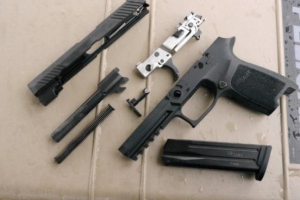About 30 years ago, the Colt 1911 handgun was replaced as the standard issue US military sidearm. The choice came down to two contenders: Beretta and SIG Sauer. Depending on which story you follow, either SIG made a big blunder on the pricing or the Italians had some intel on suitcase nukes that we needed. Either way, both companies made out well, as the Beretta M9 appeared on the hips of many Army “Joes” and the Navy Seals jumped on the SIG P226.
About the same time, Gaston Glock taught the greatest entrepreneur lesson the world had ever seen, replacing America’s Gun, that venerable Colt 1911, with the GLOCK 17 “Safe Action” Pistol. There were jokes about the tupperware case. There were scares about airport metal detectors. And by 1999 there were 2 million purchased. 5 million by 2007.
Everyone scoffed, then everyone copied the polymer, striker-fired wonder. Smith & Wesson came out with the M&P Series. Springfield Armory came out with the XD Series. Everybody started selling a polymer, striker-fired pistol – except the Ferrari of handguns, SIG Sauer. They updated and uplifted their Classic Pistol line and continued to sell pistols at twice the price (or more) of the now ubiquitous “peoples pistol,” the GLOCK.
This past year the story changed. For the first time ever, SIG Sauer began selling its very first striker-fired pistol, the P320. (They had only dabbled in polymer two or three times over the past three decades, too.) The P320 is marketed squarely at: the GLOCK. Surprise! It’s being called the GLOCK Killer.

A SIG Sauer P320 Carry arrived at JoeGLOCK HQ last month and it’s now had about three hundred rounds through it. Next month I’ll give you my thoughts on this newest GLOCK copy. For now, here’s the out-of-box experience and the features going head-to-head against GLOCK.
 The “gun” is actually a steel trigger assembly that is serialized and can be dropped into other frames and/or used with other slides. It sounds cool, and for folks that live in communist states which limit the number of handguns a citizen may own, this does provide some variety. But for those of us still living free, having three frames doesn’t really help if you want to hand your buddy a gun to shoot while you’re practicing with yours. The mags are steel – standard SIG – and you get two. Take down for field stripping is the same as a GLOCK with one big exception: you don’t have to pull the trigger. It turns out a lot of yo-yo’s out there actually shoot themselves during disassembly. <sigh>
The “gun” is actually a steel trigger assembly that is serialized and can be dropped into other frames and/or used with other slides. It sounds cool, and for folks that live in communist states which limit the number of handguns a citizen may own, this does provide some variety. But for those of us still living free, having three frames doesn’t really help if you want to hand your buddy a gun to shoot while you’re practicing with yours. The mags are steel – standard SIG – and you get two. Take down for field stripping is the same as a GLOCK with one big exception: you don’t have to pull the trigger. It turns out a lot of yo-yo’s out there actually shoot themselves during disassembly. <sigh>
The magazine release button is triangular and pushes easily. It’s got a full size rail on the dust cover with serrations on the front of the slide as well as the rear. That does make it easier to rack the slide if you’re inclined to hold forward of the ejection port. Watch that muzzle! I think it looks cool to rack it that way when I’m giving a class. 🙂 It has the same three internal safeties the GLOCK has (trigger, safety, drop) and no external safety to deal with. They even market their trigger safety as not having a split (like the GLOCK), but you can buy it with the split if you’ve got to have it.
It’s all GLOCK-ishly familiar. The only remarkable part of the gun is the trigger guard. If you’re sitting the SIG side-by-side with the GLOCK you’d think they were the same size. It certainly looks that way in the pics. They’re even the same shape! But on a cold day (like we’ve had recently) you’ll find your gloved trigger finger will fit a bit easier on the SIG. It’s actually 7mm longer (0.276 inches) than the GLOCK. I guess the cold in Exeter, New Hampshire, is a little tougher than Smyrna, Georgia.
For those of you who aren’t GLOCK fan boys (as I am) and haven’t shot with me, my go-to gun is a GLOCK 19 with an RMR (ruggedized miniature red-dot) optic and a threaded barrel for my silencer. However, if you see me on the range, more often than not I’m shooting a SIG Sauer P226 with a short-reset trigger and tactical light. Next month I’ll compare the new SIG P320 to the GLOCK 19 and the Classic SIG P226, which is old-fashioned hammer fired.

